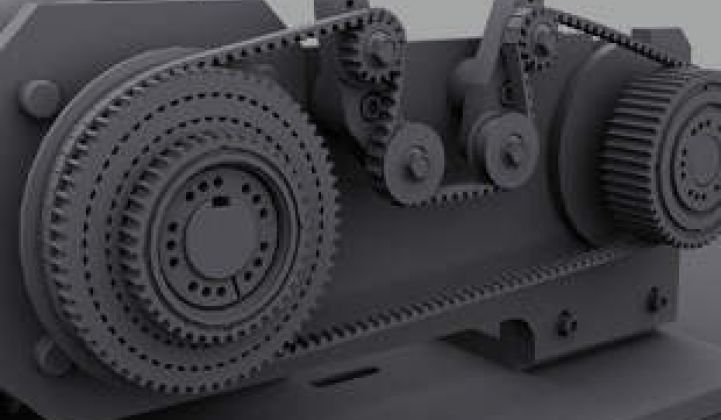Industrial motors may not be the first thing that comes to mind when one thinks of a 21st-century entrepreneur tinkering in his garage. Anthony Wong didn’t even have a garage; he only had an extra bedroom.
Wong was riding a streetcar in Toronto about five years ago, thinking about bicycle drivetrains and how to make them more efficient. Five years later, Wong’s company inMotive is almost ready for prime time with a mechatronic variable-speed drive (MVSD) -- essentially a transmission for industrial motors.
A more efficient variable-speed drive for motors could help the ubiquitous, energy-sucking devices make another leap in energy efficiency. The problem is that most motors are oversized because of high torque requirements that are only needed for a small portion of the motor’s use.
A motor at a sawmill may need the torque to push a blade through a knot in the wood, for instance, but most of the time, the oversized motors are running pretty inefficiently. Although motors have made energy-efficiency gains over the decades, the improvements mean that most efficiency gains are now incremental. Seventy-five percent of industrial motors operate at less than 60 percent capacity.
There are about 75 million electric motors that could benefit from the company’s patented technology, inMotive president Paul Bottero told journalists on a media tour in Ontario. The variable-speed drive involves gears that move under the chain, rather than a chain that moves over sprockets. The drive uses a combination of mechanical, computer, electrical and control engineering for variable speeds. (Check out a video of the technology in slow motion here.)
Bottero said the MVSD can offer double the torque of a variable-frequency drive for the same energy. He added that the drive offers about 30 percent to 50 percent lower capital costs and about 10 percent to 15 percent greater efficiency over the most efficient motors on the market.
Of course, the industrial motor industry is not necessarily welcoming to newcomers. InMotive was born out of the MaRS science and technology incubator in Toronto, which has helped it find partners. The Toronto-based company tested its prototype with one of the world’s ten largest motor manufacturers, which is based in the U.S. Currently, the company is testing its most recent prototype on a retail-distributor's 90-meter conveyor system in Ontario.
The pilot not only cut the energy needs for the retailer from about 10 horsepower down to 5 horsepower, but it has also reduced lower reactive power charges for the facility by about one-third. InMotive has the advantage of coming along at the right time. Even a decade ago, the combination of electronics, mechanics and material sciences couldn’t have built the product inMotive has developed.
While the potential market is huge globally, there is a particular need for efficient motors in India and China, where there are no minimum efficiency standards for motors. In India, nearly 40 percent of industrial sector emissions reductions could be met simply by adopting better standards for motors. Multinational firms have also become very interested in the industrial motor efficiency market in recent years. In 2010, ABB paid $4.2 billion for Baldor Electric to make a play in the industrial motor business.
InMotive has no plans to take on motor manufacturers. Instead, it wants to license its technology to motor manufacturers that would add the MVSD to products. It is looking for multinational partners to take advantage of both high-efficiency opportunities in the U.S. and Europe, as well as the growth and need for efficiency in emerging markets.
The first application is industrial motors, but the company expects to come back full circle to the inspiration for the motor in the first place: e-bikes. But that could just be the beginning, said Bottero. He sees options for automotives too, everything from low-cost four-speed automatic transmissions for emerging markets to 16-speed vehicles for the luxury market.
At this point, however, inMotive still needs to get into the industrial-motor market. Bottero said the final hurdles were not serious technical challenges, but rather tweaks to the weight of the product, integration with various motor manufacturers, and optimizing it for mass production. He added that the cost would be in line with more efficient motors already available on the market. “It’s all about price, reliability and performance,” he said. “Motors are just commodity items.”



